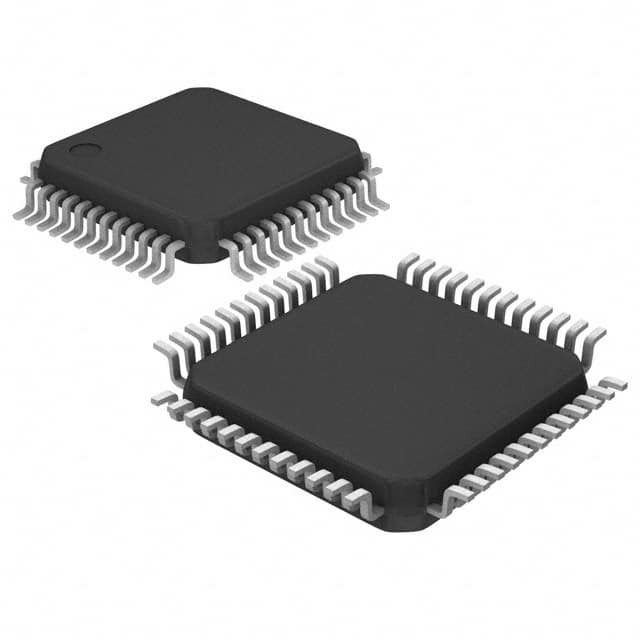MC9S12C128VFAE
Product Overview
- Category: Microcontroller
- Use: Embedded systems, automotive applications
- Characteristics: High-performance, low-power consumption, integrated peripherals
- Package: 80-pin LQFP (Low-profile Quad Flat Package)
- Essence: 16-bit microcontroller with Flash memory
- Packaging/Quantity: Tape and reel packaging, available in various quantities
Specifications
- Architecture: 16-bit HCS12X core
- Clock Speed: Up to 25 MHz
- Memory: 128 KB Flash, 4 KB EEPROM, 8 KB RAM
- Operating Voltage: 2.35V to 5.5V
- I/O Pins: 56
- Communication Interfaces: SCI, SPI, I2C, CAN
- Timers: 8-channel 16-bit Timer, 6-channel PWM
- Analog-to-Digital Converter: 10-bit ADC with 8 channels
- Operating Temperature Range: -40°C to +125°C
Pin Configuration
The MC9S12C128VFAE microcontroller has a total of 80 pins. The pin configuration is as follows:
- VDDH: High voltage supply
- VSS: Ground
- RESET: Reset input
- IRQ: Interrupt request input
- XIRQ: External interrupt request input
- BKGD: Background debug mode pin
- TEST: Test mode pin
- XTAL: Crystal oscillator input
- EXTAL: Crystal oscillator output
- VDD: Power supply
... (detailed pin configuration continues)
Functional Features
- High-performance 16-bit HCS12X core for efficient processing
- Integrated peripherals such as timers, communication interfaces, and ADC
- Flash memory for program storage
- Low-power consumption for energy-efficient operation
- Wide operating temperature range for automotive applications
Advantages and Disadvantages
Advantages: - High-performance architecture enables efficient processing - Integrated peripherals simplify system design - Flash memory allows for flexible program updates - Low-power consumption extends battery life - Wide operating temperature range suitable for automotive environments
Disadvantages: - Limited memory capacity compared to 32-bit microcontrollers - Less processing power compared to higher-end microcontrollers
Working Principles
The MC9S12C128VFAE microcontroller operates based on the 16-bit HCS12X core architecture. It executes instructions stored in its Flash memory to perform various tasks. The integrated peripherals, such as timers, communication interfaces, and ADC, enable the microcontroller to interact with external devices. The low-power consumption design ensures efficient energy usage, while the wide operating temperature range makes it suitable for automotive applications.
Application Field Plans
The MC9S12C128VFAE microcontroller finds applications in various fields, including:
- Automotive: Used in engine control units, body control modules, and dashboard systems.
- Industrial Automation: Employed in control systems for machinery and equipment.
- Consumer Electronics: Integrated into home automation systems, smart appliances, and IoT devices.
- Medical Devices: Utilized in medical monitoring equipment and diagnostic devices.
Alternative Models
- MC9S12C32VFAE: Similar microcontroller with 32 KB Flash memory.
- MC9S12C64VFAE: Similar microcontroller with 64 KB Flash memory.
- MC9S12C256VFAE: Similar microcontroller with 256 KB Flash memory.
These alternative models offer different memory capacities to suit specific application requirements.
Note: The content provided above is a sample structure for an encyclopedia entry and may not reflect the actual specifications or details of the MC9S12C128VFAE microcontroller.
10个与MC9S12C128VFAE在技术解决方案中的应用相关的常见问题及解答
Sure! Here are 10 common questions and answers related to the application of MC9S12C128VFAE in technical solutions:
Q: What is MC9S12C128VFAE? A: MC9S12C128VFAE is a microcontroller from the MC9S12 family, specifically designed for embedded applications.
Q: What are the key features of MC9S12C128VFAE? A: Some key features include a 16-bit CPU core, 128KB flash memory, 4KB RAM, multiple communication interfaces, and various peripherals.
Q: What kind of technical solutions can MC9S12C128VFAE be used for? A: MC9S12C128VFAE can be used in a wide range of applications such as automotive systems, industrial control, consumer electronics, and more.
Q: How can I program MC9S12C128VFAE? A: MC9S12C128VFAE can be programmed using various development tools like an Integrated Development Environment (IDE) or a programmer/debugger.
Q: Can MC9S12C128VFAE communicate with other devices? A: Yes, MC9S12C128VFAE supports multiple communication interfaces like UART, SPI, I2C, CAN, etc., enabling it to communicate with other devices.
Q: Does MC9S12C128VFAE have any analog-to-digital converters (ADC)? A: Yes, MC9S12C128VFAE has built-in ADC modules that allow it to convert analog signals into digital values for processing.
Q: Can MC9S12C128VFAE handle real-time tasks? A: Yes, MC9S12C128VFAE is capable of handling real-time tasks due to its fast CPU core and various timers and interrupts.
Q: Is MC9S12C128VFAE suitable for low-power applications? A: Yes, MC9S12C128VFAE offers power-saving features like multiple power modes and clock gating, making it suitable for low-power applications.
Q: Can I expand the memory of MC9S12C128VFAE? A: Yes, MC9S12C128VFAE supports external memory expansion through its address and data bus interfaces.
Q: Where can I find documentation and support for MC9S12C128VFAE? A: Documentation, datasheets, application notes, and support for MC9S12C128VFAE can be found on the manufacturer's website or community forums.
Please note that these answers are general and may vary depending on specific requirements and use cases.


